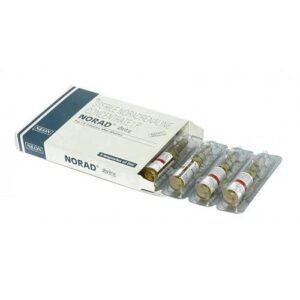NORADRENALINE
NORADRENALINE: Drug: Noradrenaline (also known as norepinephrine)
Use: Noradrenaline is a medication used to treat critically low blood pressure (hypotension). It is typically administered in hospital settings and is commonly used during surgical procedures, intensive care, and shock management.
Mechanism of Action: Noradrenaline is a naturally occurring catecholamine that acts as both a neurotransmitter and hormone in the body. It works by binding to and activating alpha and beta adrenergic receptors in the blood vessels, which causes vasoconstriction and increases peripheral vascular resistance. This action helps to increase blood pressure and improve blood flow to vital organs.
Dose: Noradrenaline is administered intravenously through a central venous catheter or large peripheral vein. The infusion rate is adjusted based on the individual patient’s blood pressure response. Typical starting doses range from 0.02 to 0.05 mcg/kg/minute and can be gradually increased if needed. The maximum recommended dose is around 3 mcg/kg/minute.
Side Effects: Some common side effects of noradrenaline include headache, dizziness, nausea, reflex bradycardia (slowing of the heart rate), and hypertension (high blood pressure). It can also cause ischemia (reduced blood flow) in peripheral tissues, so close monitoring is necessary to minimize the risk of tissue damage. Extravasation (leakage of the medication into surrounding tissues) can cause tissue necrosis and should be handled promptly. Excessive doses or prolonged use may lead to arrhythmias, myocardial ischemia, or even cardiac arrest. Careful monitoring of blood pressure, heart rate, and tissue perfusion is essential when administering this medication.

